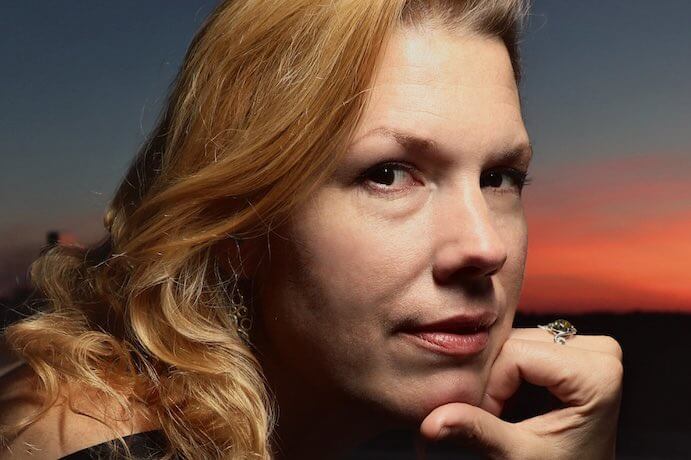Sometimes the narrative just melts away. In spaces devoted to classical and new music, murkily curtained with outdated notions, such moments soothe like sea breezes. One washed-up cliché disguised as a pearl of wisdom: composers can become notable as performers, but not vice versa. Another: artists known for vocal or instrumental performance can compose, but their focus on idiomatic writing will dilute their creativity. Holding the least water of all: to become a skilled composer, musicians need to force themselves through established conservatory-to-commission pipelines. Jessica Meyer washes all these dusty tropes away on Ring Out, her debut album on Bright Shiny Things.
Meyer appears as a violist on nine of the album’s eleven tracks, having written all six pieces, as well. She bears production credit throughout, alongside Ryan Streber, Jesse Lewis, and Bright Shiny Things’ “head ninja,” bassist Louis Levitt. The record’s release marks a watershed moment in Meyer’s emergence as a composer. After years devoted near-exclusively to developing a classical performing career, she began experimenting with a looping pedal in 2011. By 2014, she had written enough live-electronic viola music to fill an album, her recorded compositional debut: Sounds of Being. Six years ago, when she began to write for others, “the floodgates were opened.” Meyer captains a crew of excellent collaborators on Ring Out, both a co-equal performer and the navigator charting the course.

Jessica Meyer–Photo by Thomas Celan
Tracks 1-10 benefit from a consistently intimate sound, courtesy of the engineering and editing of Streber and Charles Mueller. Captured in sonic close-up, the power of Meyer’s compositions comes through in the sharply accented unisons that open But Not Until, a duo for Meyer and cellist Andrew Yee. The work draws on post-minimalist style but forcefully transcends it, and a split in pitch early on yields to notes that whip by as though by centrifugal force. Later on the album, Meyer produces a sweetly stricken sound on Only a Beginning, a duo for her and violinist Miranda Cuckson. Violin melodies float over a soft-focus viola drone, evoking summertime. More contemplative than But Not Until, this piece echoes the earlier duo in title and mood.
Cuckson and cellist Caleb van der Swaagh join Meyer on the three-movement I Only Speak of the Sun. The opening might confound listeners trying to tell the players apart; Meyer places everyone in the same pitch space. More than her other pieces, I Only Speak of the Sun recalls the Ravel-meets-minimalism signature aesthetic of ensembles like Bright Shiny Things label-mate Sybarite5. From dark haze, the second movement develops into a gorgeous soaring feature for Cuckson way up on the E string. Van der Swaagh finally dips into the bass register in the third movement, an essay in classic finale form.
Yee has a moment in the sun thanks to Released, the earliest-written work on the record. The piece itself may work better live: its latter third tapers from quiet to quieter, a glum auditory experience. Yet Yee’s grit, urgency, and sonic presence also make this track a standout, his detuned C string gnashing and wailing. If you have a chance to watch Yee play this, go! But brace yourself for the overwhelming lyricism of the piece’s climax.
Jessica Meyer–Photo by Tatiana Daubeck
Pianist Adam Marks plays a solitary note to open Seasons of Basho, answered by shuddering scraps of melody from Meyer’s viola. Marks’s piano and the extraordinary countertenor voice of Nicholas Tamagna announce that “Spring” has sprung, along with tears of loneliness. “Summer” consists mostly of a shuffling viola solo, sonic dry heat; when the piano burbles to life, Tamagna speaks. The singer’s beautiful vibrato and remarkable timbre at high pitch make his reading of “Autumn,” a soaring slow movement, glow. Marks’s piano becomes a bell, tolling in and then, wonderfully, out of sync.
Ring Out, Wild Bells finds Roomful of Teeth cartwheeling and cascading melodically. Recorded inside The Tank, an abandoned water vessel turned uniquely resonant music venue, this title track brims with bell effects. Working with a group known for ecstatic harmonies and unlikely twists, Meyer composed more in the ensemble’s voice than hers. Although the piece compromises on distinctiveness and coherence, it finds Meyer taking thrilling risks. The octet sounds amazing, from high keens to Le Mystère des Voix Bulgares-style counterpoint. Additional engineer Bruce Odland and editor Shauna Barravecchio capture something of the venue’s magic. However, listeners may come away wanting tickets to visit Rangely, Colorado more than any CD.
This collection of well-recorded, polished, at times startlingly vital performances has something for almost everyone. Thanks to designer Marian Claire Holmes and artist Lorraine Meyer, Ring Out‘s physical presence adds subtle mystery to any shelf. Tracks 5-10 in particular offer an overview of Meyer’s sensibility at its strongest. The story of her first two albums is one of an artist expanding her palette and casting expectations aside. Breaking old confining narratives of musicianship and composition, she has made them her own to rewrite.

